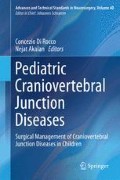Abstract
The C1–C2 joint is affected by multiple entities that may produce biomechanical instability. Optimal management for atlantoaxial instability has been searched by ways of different surgical techniques with different results, generating discussion between second effects of a particular treatment. Lateral dissections can place the axial neck musculature and ligaments at risk of neural denervations or vascular compromise. Either of these entities may result in significant postoperative atrophy, pain, and instability. Minimally invasive techniques for the treatment of spinal disorders allow to our patients less morbid procedures with equal or better results compared to conventional surgery. In the following paper, we review the anatomy of the atlantoaxial joint and propose a minimally invasive trans-muscular C1–C2 fusion technique using C1 lateral-mass screws and C2 pedicular screws. We describe cases with surgical, clinical, and radiographic follow-up.
Access this chapter
Tax calculation will be finalised at checkout
Purchases are for personal use only
References
Claybrooks R, Kayanja M, Milks R, Benzel E (2007) Atlantoaxial fusion: a biomechanical analysis of two C1-C2 fusion techniques. Spine J 7:682–688. Menendez J, Wright N (2007) Techniques of posterior C1-C2 stabilization. Neurosurgery 60 (Suppl 1):103–111
Diaz R, Berbeo M, Vergara M, Villalobos L (2009) Minimally invasive posterior C1-C2 screw fixation through an anatomical corridor preserving occipital-cervical tension band. Prospective 21 months clinical and radiological study. Oral presentation, Spine Arthroplasty Society Global symposium on motion Preservation Technology (SAS 9). London
Farey I, Nadkarni S, Smith N (1999) Modified Gallie technique versus transarticular screw fixation in C1-C2 fusion. Clin Orthop Relat Res 359:126–135
Fessler R, O’Toole J, Eichholz K, Perez-Cruet M (2006) The development of minimally invasive spine surgery. Neurosurg Clin N Am 17:401–409
Gala VC, O’Toole JE, Voyadzis JM, Fessler RG (2007) Posterior minimally invasive approaches for the cervical spine. Orthop Clin N Am 38(3):339–349; abstract v
Gerszten PC, Welch WC (2006) Spine: minimally invasive techniques. Prog Neurol Surg 19:135–151
Goel A, Laheri V (1994) Plate and screw fixation for atlanto-axial subluxation. Acta Neurochir (Wien) 129:47–53
Goel A, Desai KI, Muzumdar DP (2002) Atlanto axial fixation using plate and screw method: a report of 160 cases treated patients. Neurosurgery 51:1351–1357
Harms J, Melcher R (2001) Posterior C1-C2 fusion with polyaxial screw and rod fixation. Spine 26(22):2467–2471
Joseffer S, Post N, Cooper P, Fremong-Boadu A (2006) Minimally invasive atlantoaxial fixation with polyaxial screw-rod construct: technical case report. Neurosurgery 58(Suppl 2):ONS-375
Menendez J, Wright N (2007) Techniques of posterior C1-C2 stabilization. Neurosurgery 60(Suppl 1):103–111
Neo M, Sakamoto T, Fujibayashi S, Nakamura T (2005) A safe screw trajectory for atlantoaxial transarticular fixation achieved using an aiming device. Spine 30(9):236–242
O’Toole JE, Eichholz KM, Fessler RG (2006) Minimally invasive approaches to vertebral column and spinal cord tumors. Neurosurg Clin N Am 17(4):491–506
Powers C, Isaacs R (2006) Minimally invasive fusion and fixation techniques. Neurosurg Clin N Am 17:477–489
Reilly T, Sasso R, Hall P (2003) Atlantoaxial stabilization: clinical comparison of posterior cervical wiring technique with transarticular screw fixation. J Spinal Disord Tech 16(3):248–253
Shad A, Shariff S, Teddy P (2002) Craniocervical fusion for rheumatoid arthritis: comparison of sublaminar wires and the lateral mass screw craniocervical fusion. Br J Neurosurg 16(5):483–486
Shchedrenok VV, Ivanenko AV, Sebelev KI, Moguchaia OV (2010) Minimally invasive surgery of degenerative diseases of the spine. Vestn Khir Im I I Grek 169(2):102–104
Wang M, Levi A (2006) Minimally invasive lateral mass screw fixation in the cervical spine: initial clinical experience with long-term follow-up. Neurosurgery 58:907–912
Winder MJ, Thomas KC (2011) Minimally invasive versus open approach for cervical laminoforaminotomy. Le Journal Canadien Des Sciences Neurologiques 38(2):262–267
Xiang-Yang M, Qing-Shui Y, Zeng-Hui W, Hong X, Jing-Fa L, Shi-Zhen Z (2005) Anatomic considerations for the pedicle screw placement in the first cervical vertebra. Spine 30(13):1519–1523
Yoshida M, Neo M, Fujibayashi S, Nakamura T (2006) Comparison of the anatomical risk for vertebral artery injury associated with the C2-pedicle screw and atlantoaxial transarticular screw. Spine 31(15):513–517
Author information
Authors and Affiliations
Corresponding author
Editor information
Editors and Affiliations
Rights and permissions
Copyright information
© 2014 Springer International Publishing Switzerland
About this chapter
Cite this chapter
Díaz, R., Berbeo, M.E., Villalobos, L.M., Vergara, M.F., Osorio, E. (2014). Minimally Invasive Posterior Trans-muscular C1–C2 Screw Fixation Through an Anatomical Corridor to Preserve Occipitocervical Tension Band: Surgical Anatomy and Clinical Experience. In: Di Rocco, C., Akalan, N. (eds) Pediatric Craniovertebral Junction Diseases. Advances and Technical Standards in Neurosurgery, vol 40. Springer, Cham. https://doi.org/10.1007/978-3-319-01065-6_8
Download citation
DOI: https://doi.org/10.1007/978-3-319-01065-6_8
Published:
Publisher Name: Springer, Cham
Print ISBN: 978-3-319-01064-9
Online ISBN: 978-3-319-01065-6
eBook Packages: MedicineMedicine (R0)

